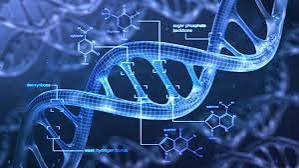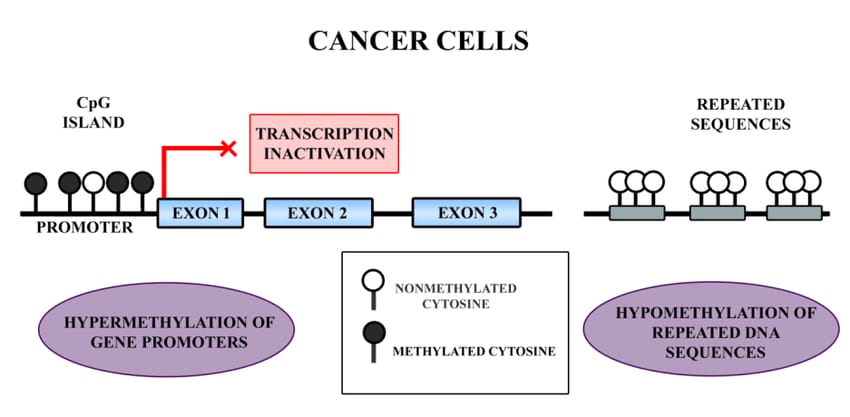What is DNA Methylation
Published on 29 Feb 2024
Biology
DNA methylation is a type of epigenetic modification that adds methyl groups to the DNA molecule. The process can alter the activity of a DNA region without affecting its sequence. When DNA methylation occurs in a gene promoter, it normally serves to suppress gene transcription. In mammals, DNA methylation is required for normal development and is linked to a variety of important processes such as genomic imprinting, X-chromosome inactivation, transposable element suppression, ageing, and cancer.
DNA methylation and splicing of genes are the intricate biochemical processes that control gene expression and perform a variety of functions related to cellular development, differentiation and genome integrity. DNA methylation is a process where a methyl group is added to a cytosine base in a CpG dinucleotide setting, giving 5-methylcytosine. This transformation is conducted by DNA methyltransferases, which are enzymes that obtain the methyl group from S-adenosyl methionine for transfer to cytosine. CpG methylation predominantly takes place in CpG dinucleotide-rich regions, which are called CpG islands and are commonly present in the promoter regions of genes. Methylation can be either suppressive or epigenetic in its action, depending on the site. Gene expression usually gets eliminated by the promoter methylation leading to the disruption of the transcription factors binding or attracting repressive chromatin-modifying complexes.

Gene splicing is also post-transcriptional but is necessary for the formation of mature mRNA molecules which are translated into protein. Pre-mRNA, which is brought about by transcription from a DNA template, not only has both exons (coding sections) and introns (non-coding regions), it also has other secondary RNA
domains. Splicing is catalyzed by the spliceosome, an assembly of small nuclear ribonucleoparticles (snRNPs). The process includes intron removal and exon ligation, giving rise to a continuous coding sequence. Equally important is alternative splicing which adds a level of complexity by enabling the use of various exon combinations or exclusions that results in the production of many mRNA isoforms from one gene. Such biological diversity also increases the same plurality of proteome and working.
The interconnection of methylation and splicing is commonly seen as a mechanism of gene regulation that can control gene expression patterns. DNA methylation can have a direct impact on splicing in two different ways, the recruitment of splicing factors may be changed or the histone structure may be altered. Splice variants, however, frequently impact DNA methylation patterns by either directing recruitment of DNA methyltransferases or demethylases. The mutually integrated role of these systems further complicates the issue.
.jpeg)
Understanding the mechanics of DNA methylation and gene splicing is critical not only for unravelling the intricacies of biological processes, but also for getting insight into diseases caused by abnormal regulation. Dysregulation of DNA methylation and splicing has been linked to a variety of illnesses, including cancer. In a case called hypomethylation, carcinogenesis is enabled and inappropriate silencing of tumor suppressors occurs. By contrast, oncogenes are activated and expressed leading to progression of cancer. Study conducted by scientists at Indiana University School of Medicine in 2002 has led to a conclusion that change in enzymes enabling DNA methylation might contribute to expression of ovarian cancer specifically.

Another condition closely related to DNA methylation is cardiovascular disease. Namely, it causes atherosclerosis. Regardless of whether it’s hypermethylation or hypomethylation, the consequences are relatively similar. Following alteration in the structure and function of tissues like smooth muscle and endothelium, a condition called atherosclerosis starts to develop. If not taken care of, atherosclerosis might and will transform into cardiovascular disease where the lumen is restricted with plaque formations, thus, reducing rate of delivery of ATP.
.jpeg)
With biotechnology breaking through, new routes for DNA methylation regulation have been revealed. While they have an enormous chance to speed up scientific studies and medical remediation, these interventions simultaneously create serious ethical problems that have to be examined carefully. The potential for unintended consequences is one of the ethical issues with which the modification of DNA methylation is
associated. Genomes' methylation patterns that are altered in one part may have unpredictable effects on genes expression in other regions that may cause unexpected biological changes. This pinpoints on the necessity for conducting exhaustive experiments and risk analyses before applying any extensive DNA methylation modification practice.
The issue of consent and autonomy is also for consideration. Patients must be given clear and full information on any dangers and effects associated with the use of DNA methylation manipulation if it is applied in a clinical situation, i.e. the treatment of genetic diseases. In order to avoid interference with the personal agency of individuals to decide about this kind of treatment, informed consent is necessary.
Among the problems that are associated with methylation are the impacts on the generation coming later
on. This could be unethical if modifications made to the DNA methylation patterns of an individual could also be inherited by their offspring without their consent since they did not edit their DNA themselves.
Talking about it in conclusion, DNA methylation plays an important role in the regulation of genes and biological functions. It is a complicated system of which diversity and the complexities of living things is a part. Medical, genetics, and epigenetics are some of the biological systems to be largely benefited from a comprehending of DNA methylation patterns and functions. Knowing how genetic engineering affects human health and diseases, the research in this area needs to be advanced. This will be an incentive for the creation of novel therapies and personalized medicine.